Swansea Tramways
History
Swansea's first horse-drawn tramway service ran on the 12th April 1878 on the newly opened, standard-gauge line of the Swansea Improvements and Tramways Company. The SI&TCo was highly unusual in that it not only acquired powers to build and operate a tramway, but also to 'improve' the town, principally by building new thoroughfares, the main streets being too narrow for tramway tracks. Although the company had been formed in October 1873, with Royal Assent granted on 16th June 1874, it took nearly four years to open the tramway, primarily due to difficulties in acquiring property, but also to issues with contractors.
The company's first lines had been built with the full cooperation and support of the corporation, but the relationship soured when the company applied to construct an extension to Cwmbwrla, having not yet finished all the lines it already had powers for. To add insult to injury, the company proposed to work this line (and others) with steam traction, seemingly without having consulted the corporation first, a step which was hardly designed to endear it to the latter. The steam trams (of which there were three) had actually been purchased to work the SI&TCo's Swansea and Mumbles Railway services, being introduced on the 7th August 1877, but withdrawn one year later, in August 1878, following a legal ruling. Although the engines had managed to work the flat, coastal S&MR, the Cwmbwrla line was a different proposition, and this, coupled with their general unreliability and a fatal accident, saw them withdrawn again after two years' of street tramway operation.
At its maximum, the horse tramway system comprised circa 5.5 route miles, running: northwards to Morriston; southwards to the docks; southwestwards to St Helens; and northwestwards to Cwmbwrla.
In June 1897, the SI&TCo applied for powers to convert the horse lines to mechanical traction, the corporation doing likewise; the latter's application was, however, rejected (by Parliamentary Committee) as "being of too speculative a nature for municipal investment", whilst the company's gained approval (on the 6th August 1897). Prior to this, the SI&TCo had been engaged in a dialogue with the British Electric Traction Company, a company which would, over the course of its existence, go on to either own, part-own or lease almost 50 tramway systems across the British Isles, but which at this time, was aggressively purchasing horse and steam-operated tramways, with the intention of converting them to electric traction. Following the acquisition of powers to convert the tramway, the BETCo then purchased a controlling interest in the SI&TCo.
In 1899, the BETCo pressed ahead with converting the horse lines, but also applied for powers to build further extensions; these were, however, successfully opposed by the corporation. The corporation also managed to stand in the way of conversion work, refusing permission until unspecified sums of money had been paid by the company 'in recognition of the corporation's rights', extortionary tactics that no doubt reflected the corporation's ire at having lost out to the company.
The last horse service eventually ran on the 29th June 1900, with the first electric service running the next day, in fact, gleaning the accolade of being the first electric tramway service in all of Wales.
The corporation was not done duelling with the SI&TCo, and in 1902 it sought powers to build extensions to the tramway, which were granted later that year, though it then rather perversely elected to use an obscure system of surface contact current collection, ostensibly to avoid the impact of overhead wires. The SI&TCo immediately and firmly informed the corporation that it would under no circumstances work a system so equipped, given that the existing overhead current system was perfectly good. The corporation, which had no powers to work the system, was now in a cleft stick of its own making, and had to publicly and humiliatingly alter its position. Although many authorities toyed with the idea of surface contact systems, in the case of Swansea, one can't help wondering how much the resolution to use this method was influenced by the corporation's desire to get one over on the company. In the end, all that was achieved was to quite unnecessarily delay the construction of much-need extensions.
The corporation-owned extensions were eventually opened in 1905, along with one out to Ynysforgan owned by Glamorganshire County Council; operation of all the new lines was leased to the SI&TCo. Although it now owned around 6.5 miles of tramway, the corporation had still not given up on the idea of running a municipal tramway, and at the same time exacting revenge on the company, as yet another effort was made to purchase the tramway, with the Board of Trade firmly squashing the attempt. It was in fact to take the two parties until 1911 before they were finally able to reach a lasting agreement.
The corporation built a few short extensions in 1913, taking the system to its final size of 13.36 miles, 5.57 miles owned by the company, 7.17 miles by the corporation, and 0.62 miles by Glamorgan County Council. Lines ran: northwards to Brynhyfryd and Ynysforgan; eastwards to Port Tennant; southwards to the docks; southwestwards to St Helens and Brynmill; westwards to Sketty; and northwestwards to Cwmbwrla. The tramway system was physically connected to the S&MR at the Slip during the horse-tram era, and through services were indeed operated for a short time, however, as far as is known, whilst the tracks remained connected during the electric era, there was never any electrical connection.
The system was profitable, but suffered like many other systems during the Great War from lack of maintenance, staff shortages and an inability to source spares, track or new vehicles. Traffic was also heavy during the conflict, primarily due to munitions work, but fell away during the 1920s as bus competition and the general downturn in industry made itself felt. Despite this, major track renewals were undertaken, and the tramcar fleet was upgraded by reconstruction, new-builds and new purchases, such that it could easily have lasted until well into the 1940s.
The SI&TCo had become an omnibus operator during the 1890s by virtue of buying out competitors and then working the services (those not directly competing with the trams) itself. In February 1914, however, it set up a subsidiary company — the South Wales Transport Company — specifically to run buses, the first petrol bus service being introduced on the 2nd May 1914. The bus services were initially expanded, but were then reigned back during the Great War, being impacted by the widespread rationing of petrol and requisition of vehicles. The bus services were significantly expanded during the 1920s, both as feeders to the tramway, and to areas not served by the trams, including towns as far away as Neath and Llanelly. In 1927, in a strange kind of reverse takeover involving a share exchange, the SWTCo effectively took control of SITCo, giving a firm indication to any who cared to see, that the future lay with the buses.
By the mid-1930s, passenger numbers had dropped significantly, and with the buses now carrying almost twice as many passengers as the trams, and the general mood of the times turning against the tram, it was hardly surprising that the company announced — in 1935 — that it would seek approval to abandon the tramway, the Ynysforgan extension having already been replaced by buses in the early 1930s. Although this met with strong opposition from the public and the council, the latter were eventually mollified, the first closure on the main part of the system taking place on the 6th March 1937, and the last tram of all running on the 28th June 1937.
Uniforms
For such a busy industrial city, photographs of the horse- and steam-tram era are surprisingly rare. What few there are suggest that drivers and conductors wore informal attire, along with an arm band that presumably marked them as company officials. However, given that buttons bearing the city's unofficial arms and the full name of the company have survived (see link), there is a possibility that uniforms were issued at some point, though this may only have been to senior grades (e.g., inspectors) or to staff working the steam services on the Swansea and Mumbles Railway.
Conversion to electric traction took place under the auspices of the BETCo, staff working the new electric services wearing the familiar and largely regulation BETCo uniform; although jackets appeared to vary somewhat between BETCo systems, as well as across the decades, the cap badges, collar designations and buttons invariably followed a standard pattern. Photographs of the early years are scarce, however, an excellent studio portrait has survived (see below), which reveals that tramcar crews were initially issued with double-breasted jackets with five pairs of buttons (bearing the standard BETCo 'Magnet and Wheel' device — see link) and lapels, with the top two buttons protruding between the lapels and the collars; the latter carried embroidered system initials, 'S & I T'. The uniform is reported to have been navy blue with gold braiding, the latter presumably referring to the embroidered system initials. Caps were initially in a kepi-style, and bore embroidered 'S & I T' systems initials on a hat band. These caps were relatively quickly superseded by peaked caps, possibly soft-topped for a short while, but then with tensioned crowns (tops); these bore the standard BETCo 'Magnet & Wheel' cap badge, above an employee number, all almost certainly in brass. Although tramcar crews initially wore the arm bands that were used in the horse era, it would appear that these quickly fell out of use.
The style of the uniforms was changed in the mid-to-late Edwardian era to a single-breasted design with stand-up collars; the collars carried brass system initials on the bearer's right-hand side ('S I & T') in individural brass letters, and an employee number on the other side (in brass numerals). Uniform jackets were eventually changed back to a double-breasted design some time in the 1920s; this later design had five pairs of buttons (four on the body and one between the lapel and the collar). Photos also exist from the 1920s showing that script-lettering cap badges — 'Motorman' and 'Conductor' — were occasionally worn.
Brass licence badges (inlaid with red paint) have survived in significant numbers (see below); these were hung by a leather strap, usually from a jacket button, and were introduced shortly before the Great War.
Inspectors wore single-breasted jackets with hidden buttons (or more likely a hook and eye affair) and four slit pockets (two breast and two waist), all edged in a finer material than the main body of the garment; the stand-up collars bore the grade – 'Inspector' – in embroidered script lettering. The standard ‘Magnet & Wheel’ cap badge was worn on the cap, above a hat band bearing the grade — 'Inspector' — in embroidered script-lettering.
In common with many tramway systems, the SI&TCo employed female staff during the Great War to replace male employees lost to the armed services. These ladies were issued with tailored single-breasted jackets with four pockets (with button closures), a waist belt (with button fastening), lapels and epaulettes; both the lapels and epaulettes would appear not to have carried any insignia. A long matching skirt was also worn. Headgear took the form of a waterproof bonnet that carried the standard BETCo 'Magnet & Wheel' cap badge, probably affixed to a hat band. Conductresses were also issued with municipal licence badges, which the one surviving photograph reveals to have been attached to the bearer's ticket punch strap.
Further reading
For more information on Swansea's tramways, see: 'Swansea's Street Trams: The Story of Swansea Improvements and Tramways Co.Ltd.'; Swansea Maritime & Industrial Museum (1994).
Images
Horse drivers and conductors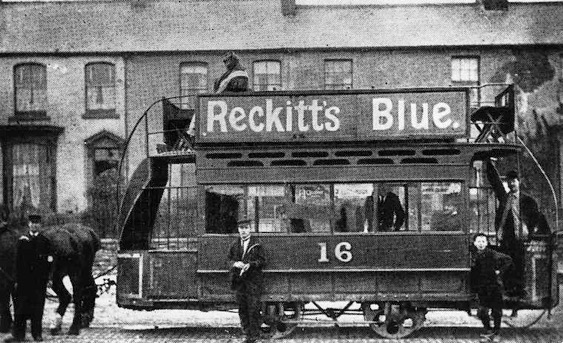
Horse Car No 16 — photo undated. The individual on the left is clearly wearing an arm band of some description, presumably either a licence badge or some other means of official identification. It is unclear whether he is wearing a uniform, though in all likelihood it is merely informal attire. Photo courtesy of David Beynon.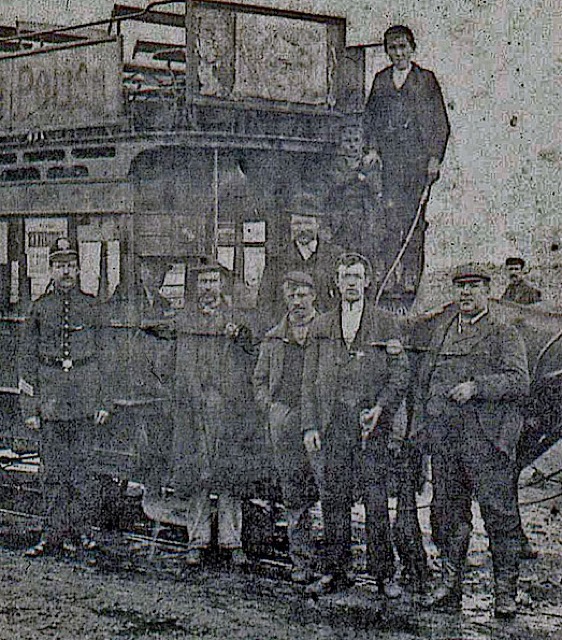
A poor-quality photograph of Horsecar No 38, possibly standing at Landore, but one which again shows that conductors, at least (see the individual second from the right), wore some kind of arm band — photo undated. Photo courtesy of David Beynon.
Motormen and conductors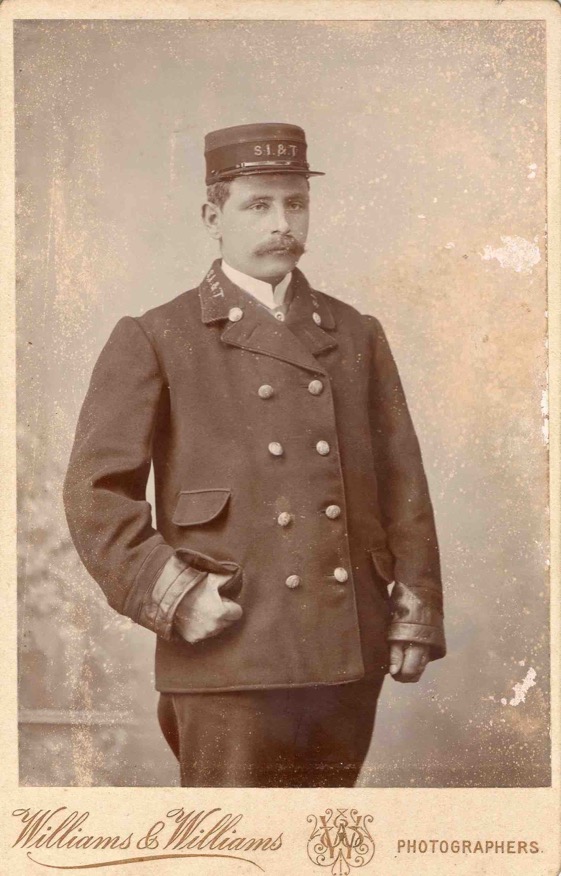
A superb studio portrait of a Swansea Improvements and Tramways Company tramwayman — photo undated, but very probably taken around the time the first electric services were introduced, i.e., summer 1900. The photographers (Williams & Williams), had several premises in South Wales and Western England, and appear to have been in business between 1895 and 1901. Author's Collection.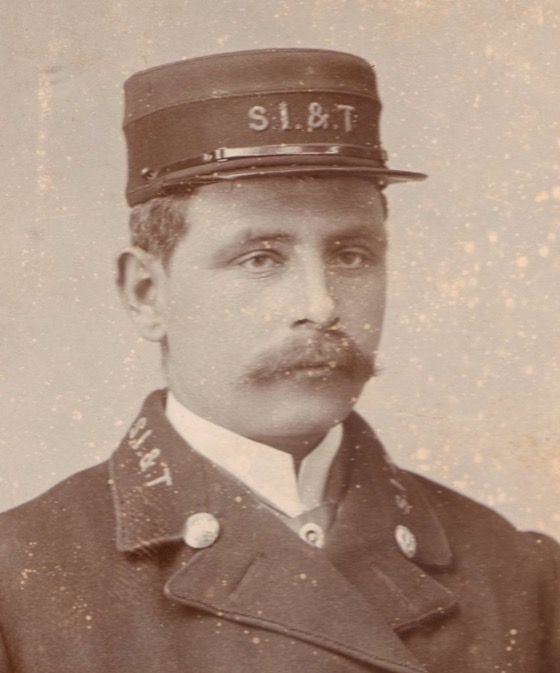
An enlargement of the above photograph showing details of the uniform. The buttons are the standard BETCo 'Magnet & Wheel' pattern, indicating that the photograph must have been taken after the take-over of 1897. Both the cap and the collars bear embroidered company initials, 'S I & T'.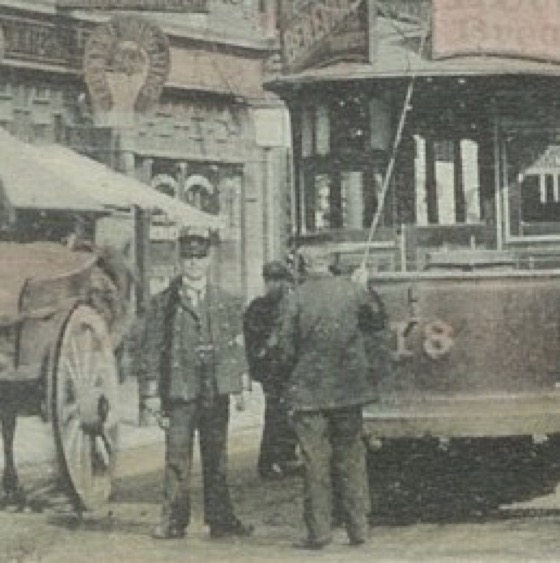
The crew of Brush single-deck Tramcar No 18 in High Street — photo undated, but probably taken around 1900/1901. The motorman (on the left) would appear to be wearing a soft-topped cap and an arm band. Photo courtesy of the Tramways and Light Railway Society, with thanks to David Voice.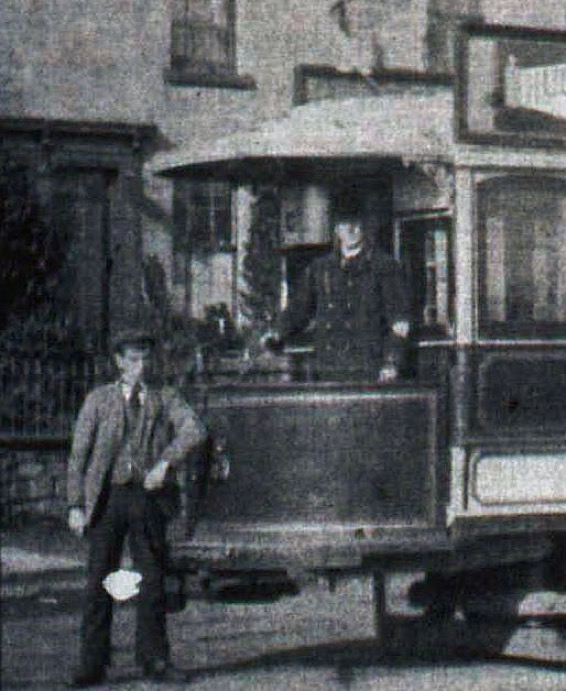
Tramcar No 25 at the Duke terminus on the Morriston route in 1900. Both the conductor (in informal attire) and the motorman, are wearing arm bands. Photo courtesy of David Beynon.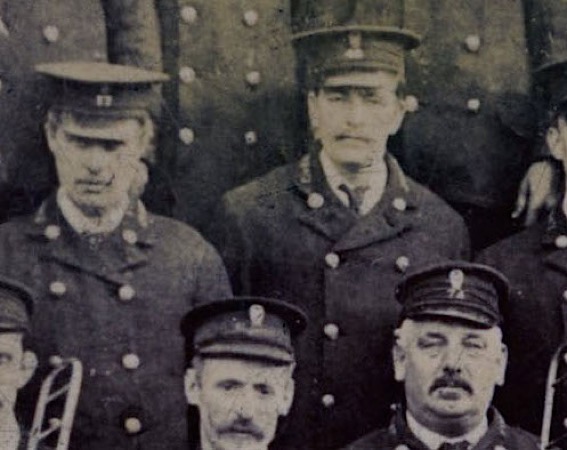
An enlargement of a larger photograph of the Swansea Tramways Choir — photo undated, but probably early Edwardian. The BETCo 'Magnet & Wheel' cap badges and employee numbers are clearly seen. The collar insignia appear to be embroidered. Photo courtesy of David Beynon.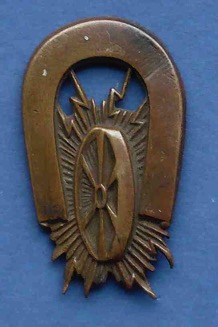
Standard British Electric Traction Company ‘Magnet & Wheel’ cap badge, as worn by staff of the Swansea Improvements and Tramways Company from the early Edwardian era onwards — brass. Author's Collection.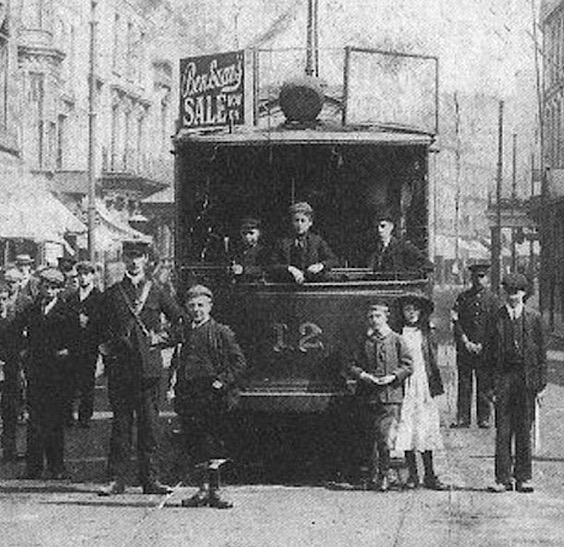
Tramcar No 12 in High Street — photo undated, but probably mid-Edwardian. The conductor is wearing a single-breasted tunic and a tensioned-crown peaked cap. Photo courtesy of David Beynon.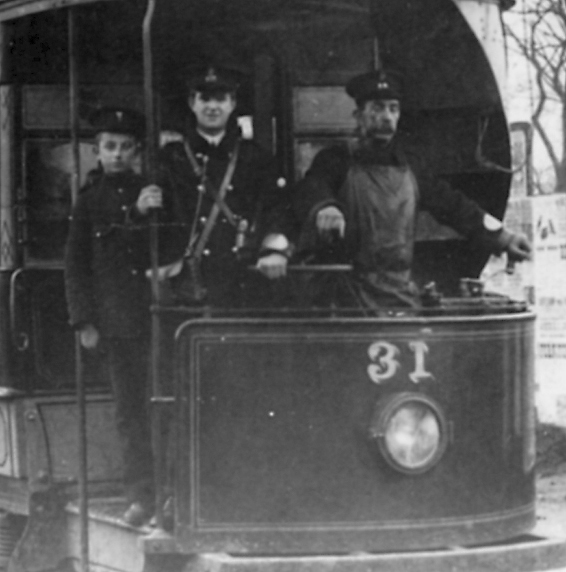
A parcels or points boy, a conductor and a motorman (in leather apron) with Tramcar No 31 on a service for High Street — photo undated, but probably mid-Edwardian given that the vehicle is in open-topped condition in this photo (it was top-covered in 1907/8). The conductor and the motorman are wearing the standard BETCo 'Magnet and Wheel' cap badge above an employee number. Photo courtesy of the Tramways and Light Railway Society, with thanks to David Voice.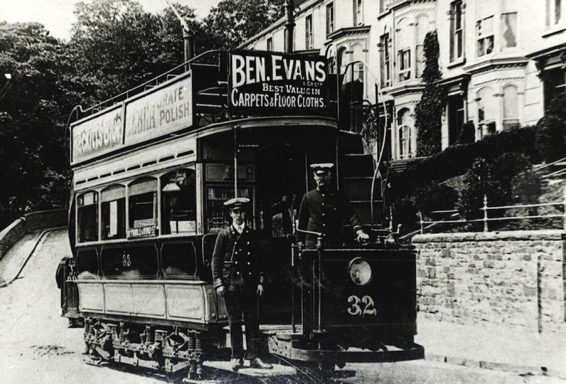
The crew of Tramcar No 32 stand at the Brynmill terminus — photo dated 1907. Photo courtesy of West Glamorgan Archive Service.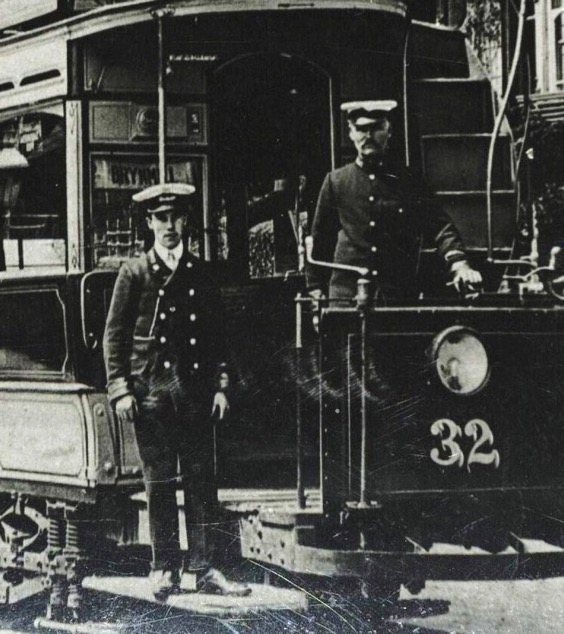
An enlargement of the above photograph showing the conductor and the motorman, the former in a double-breasted jacket with lapels and the latter in a single-breasted jacket with stand-up collars.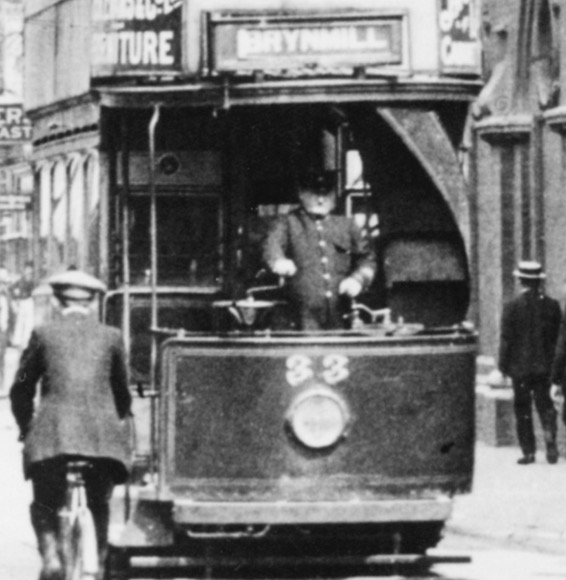
A motorman at the controls of Tramcar No 33 — photo purportedly taken in 1909, though it may actually be later than this. Photo courtesy of the Tramways and Light Railway Society, with thanks to David Voice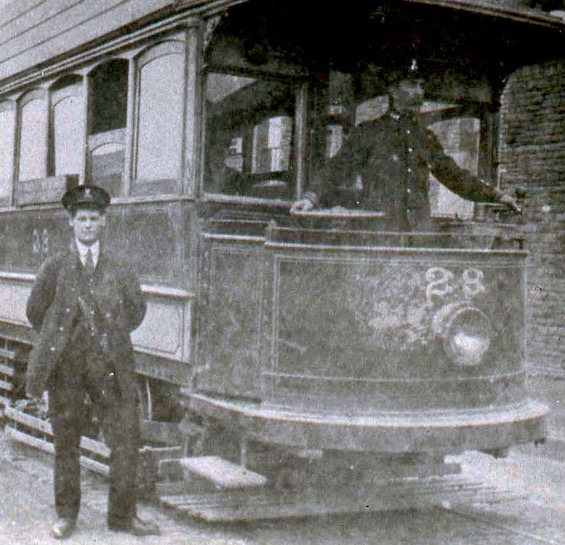
A conductor and a motorman with single-deck tram No 28 at Ynysforgan Midland Terrace — photo undated, but probably taken shortly before the Great War. Photo courtesy of David Beynon.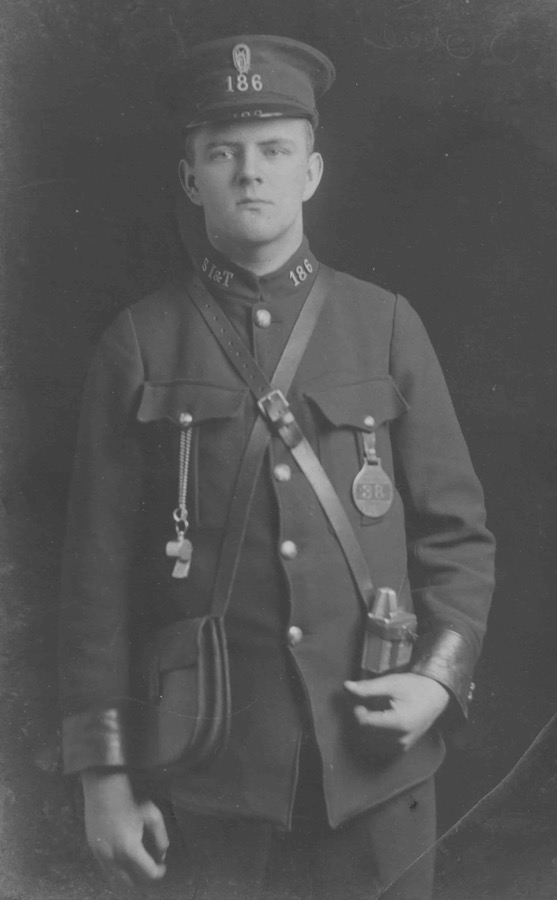
A lovely studio portrait of a SITCo conductor – called Sid – taken at Xmas 1913. Author's Collection.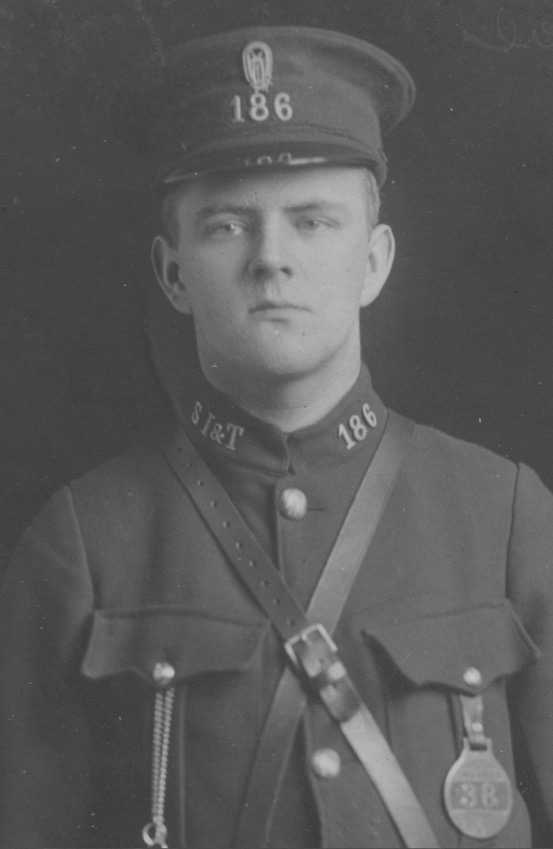
An enlargement of the above photograph showing details of the uniform insignia. The jacket clearly carries individual system initials – 'S I & T' – on the bearer's right-hand collar, and an employee number on the left; the subject is Empoyee No 186, holder of Licence Badge No 38.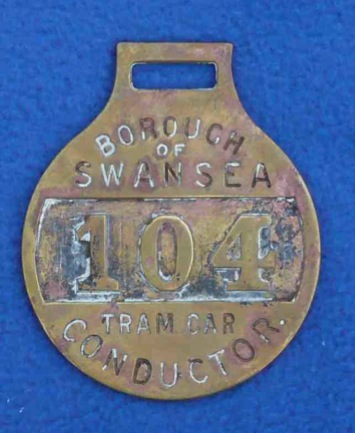
A conductor's licence badge — brass and red paint (originally this surrounded the number). These appear to have been introduced some time shortly before the Great War. Author's Collection.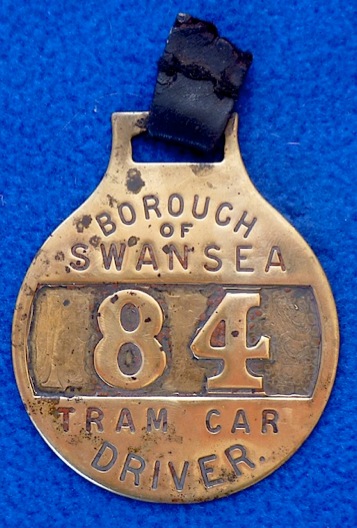
A driver's licence badge — brass. Author's Collection.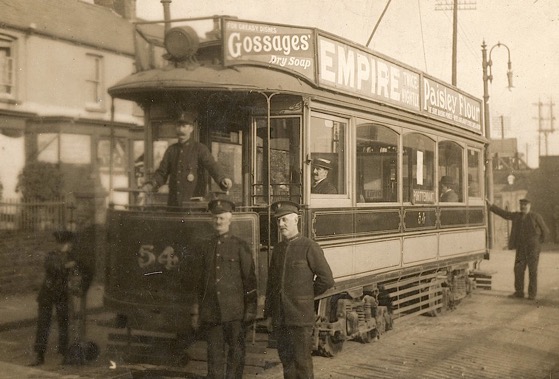
A parcels boy (holding a trolley), a motorman, a conductor and an inspector with Tramcar No 54 at the terminus at Port Tennant — photo undated, but given that this vehicle was only introduced in 1919 (replacing the original No 54), it was probably taken in that year or very shortly thereafter. Richard Rosa Collection.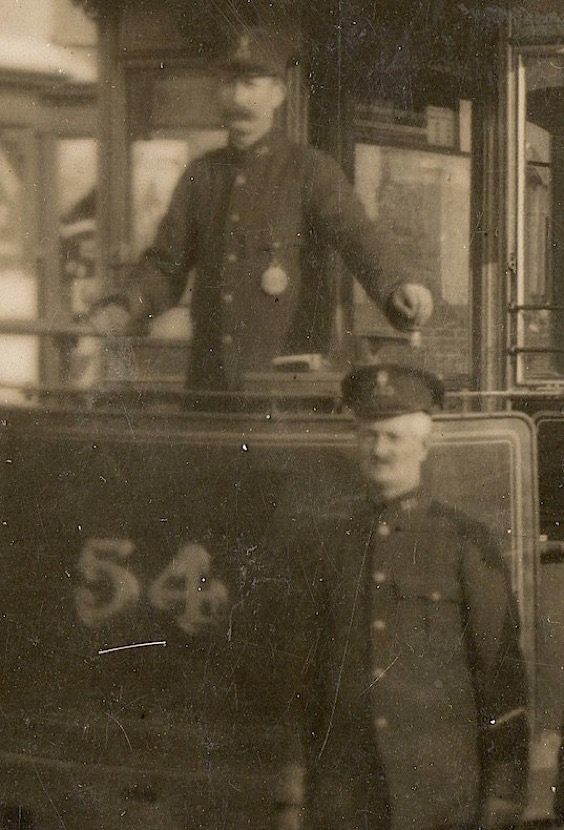
An enlargement of the above photograph showing the motorman and the conductor. Although blurred, the conductor clearly has a chevron on his left sleeve, probably denoting either good conduct or long service.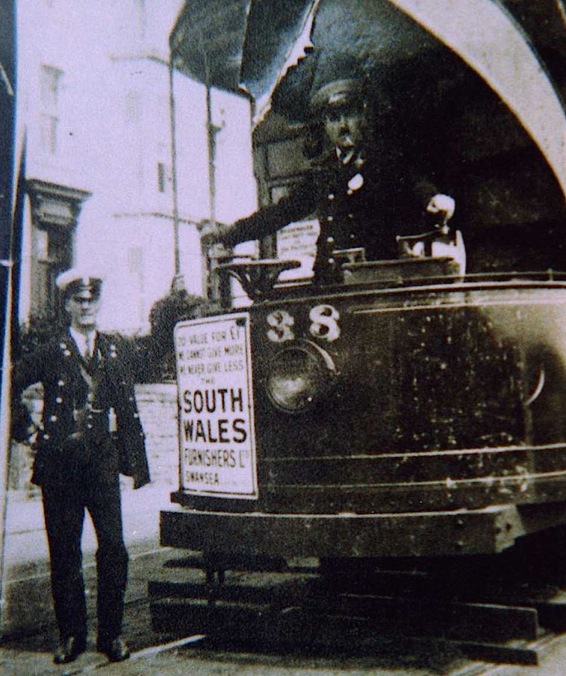
A conductor and a motorman with Tramcar No 38 at the Brynmill terminus, some time between 1925 and 1929. The motorman (right) is wearing a script-lettering 'Motorman' cap badge along with a municipal licence badge (on his left breast). Photo courtesy of David Beynon.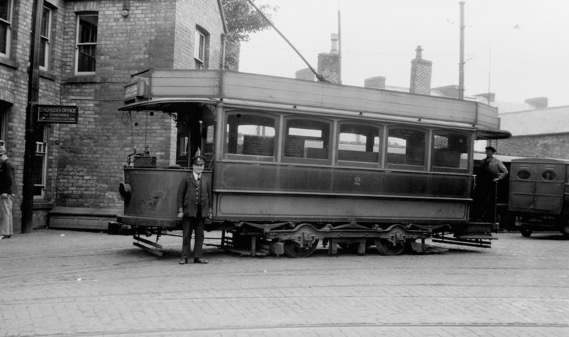
A motorman with Works Car No 2 outside St Helen's depot — photo undated, but probably taken in the 1930s. Photo by H Nicol, courtesy of the National Tramway Museum.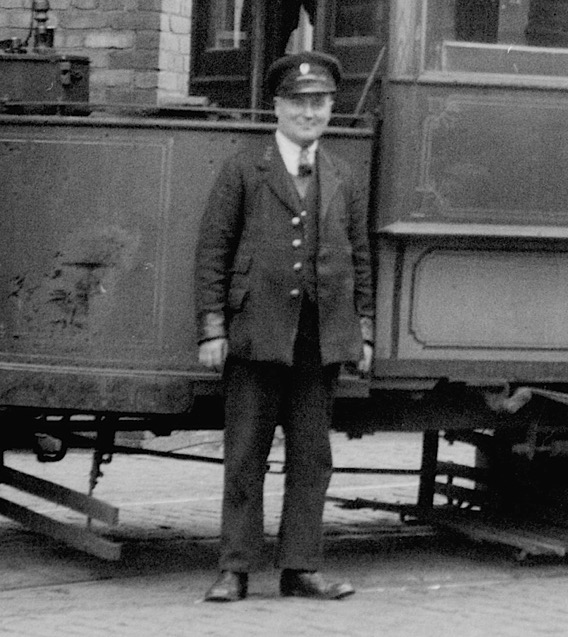
An enlargement of the above photograph showing the motorman.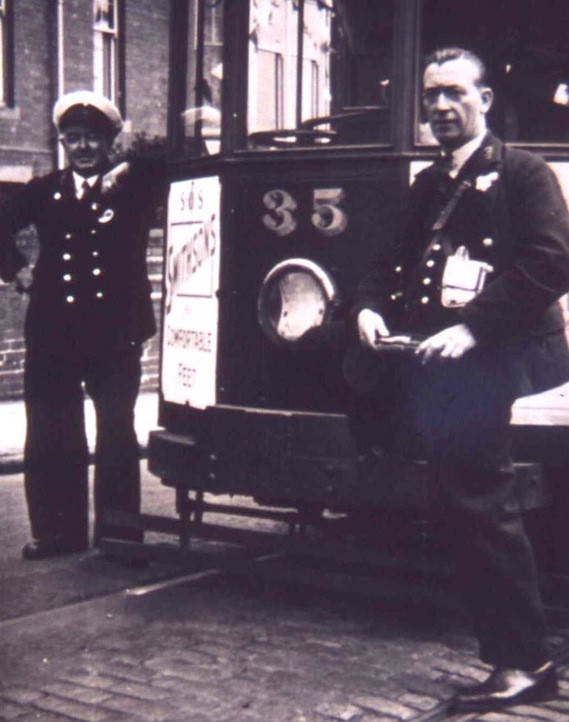
A conductor and a motorman with Tramcar No 35 at the Brynmill terminus, some time between 1930 and 1934. The motorman (left) is clearly wearing a round municipal licence badge (see above). Photo courtesy of David Beynon.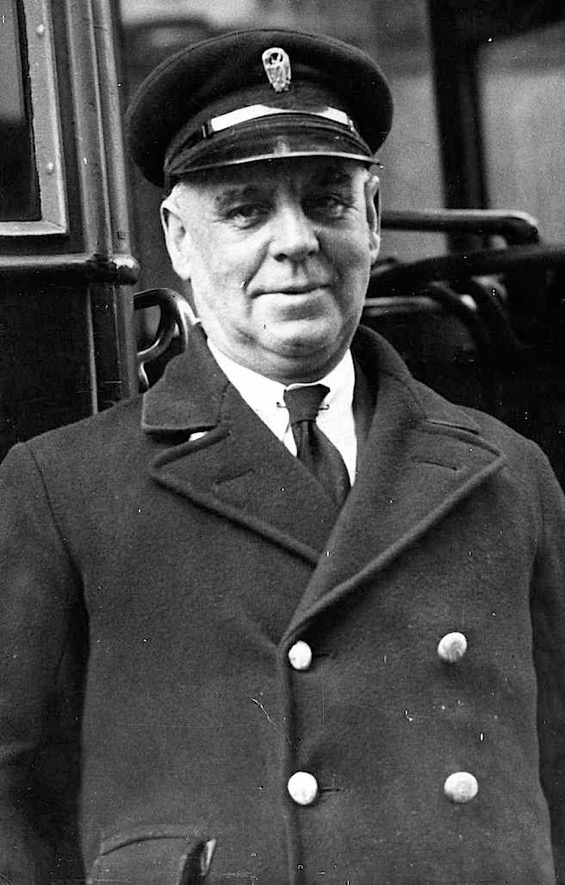
Motorman George Johns, who was the driver of the last tram to work the Morriston Section on the 6th March 1937 — photo undated, but probably taken at or shortly before closure. Apart from the buttons and the standard 'Magnet and Wheel' cap badge, the uniform bears no other insignia. Photo courtesy of David Beynon.
Senior staff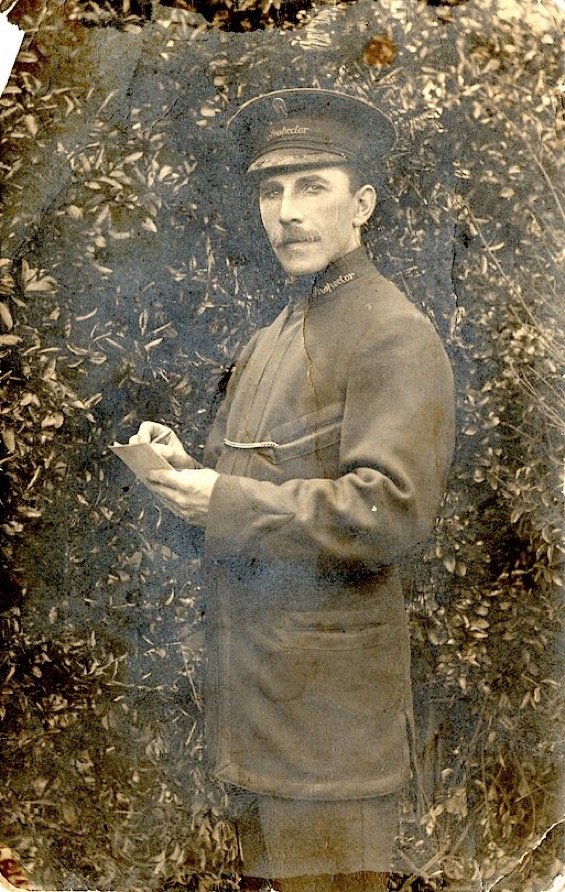
A portrait of a Swansea Improvements and Tramways Company inspector — photo undated, but probably Edwardian. The rear of the card has 'J B Morgan' written on it, though whether this is the subject is unclear. Author's Collection.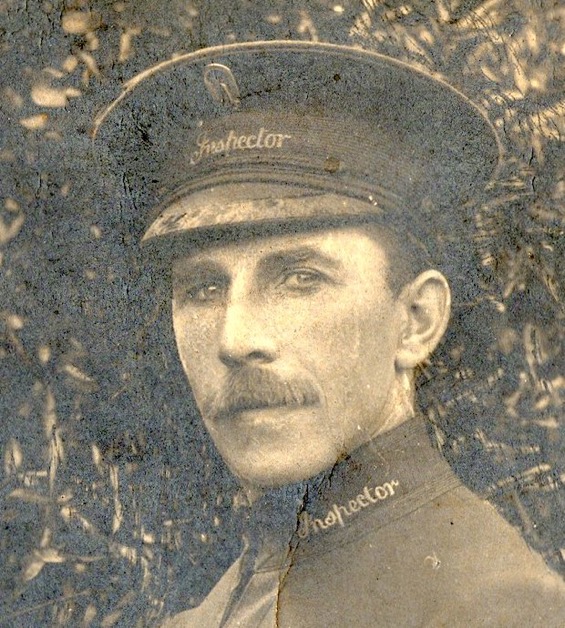
An enlargement of the above photograph showing the embroidered badges and BETCo 'Magnet & Wheel' cap badge.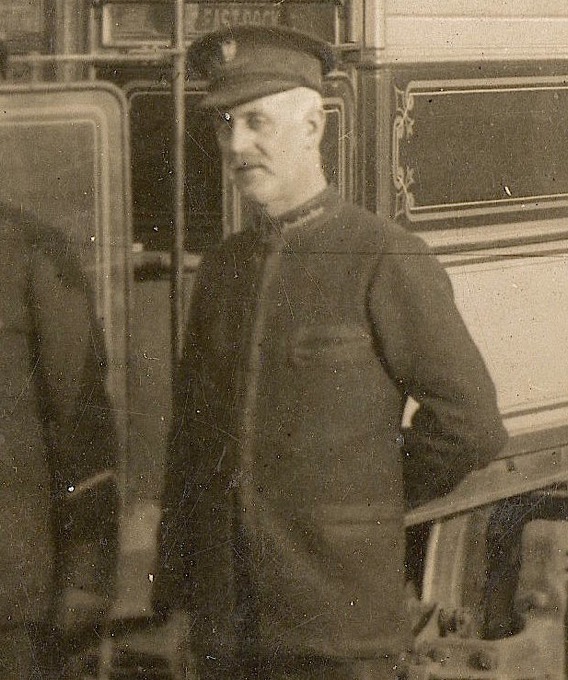
An enlargement of the post-Great War shot of Tramcar No 54 above, showing the inspector.
Female staff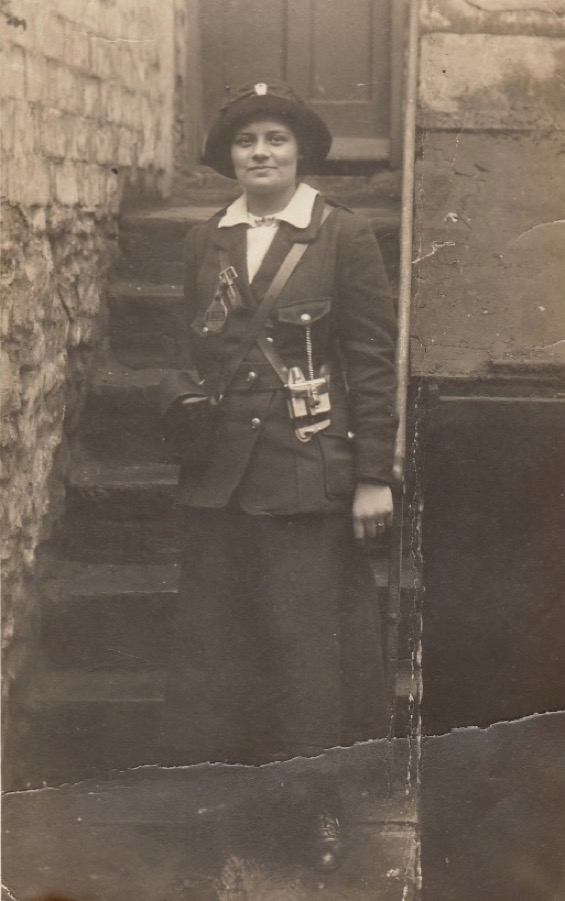
A Swansea Improvements and Tramways Company conductress — photo undated, but probably taken during or shortly after the Great War. Although it is unclear whether the subject is a tram or bus conductress, in all likelihood they wore the same uniform. Photo courtesy of the Stephen Howarth Collection.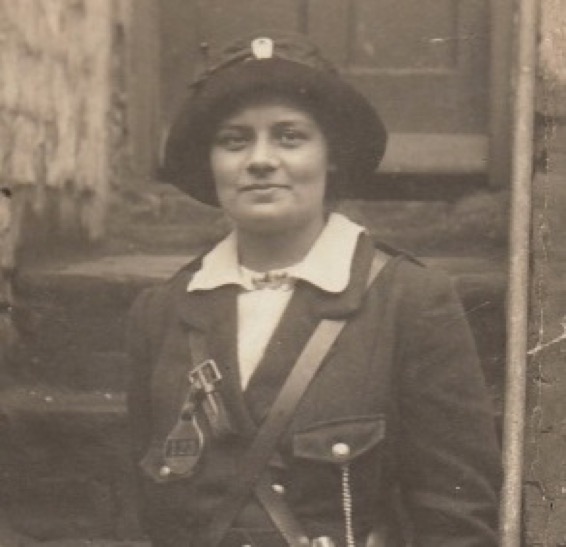
An enlargement of the above photograph revealing the subject to be the bearer of Licence Badge No 123.